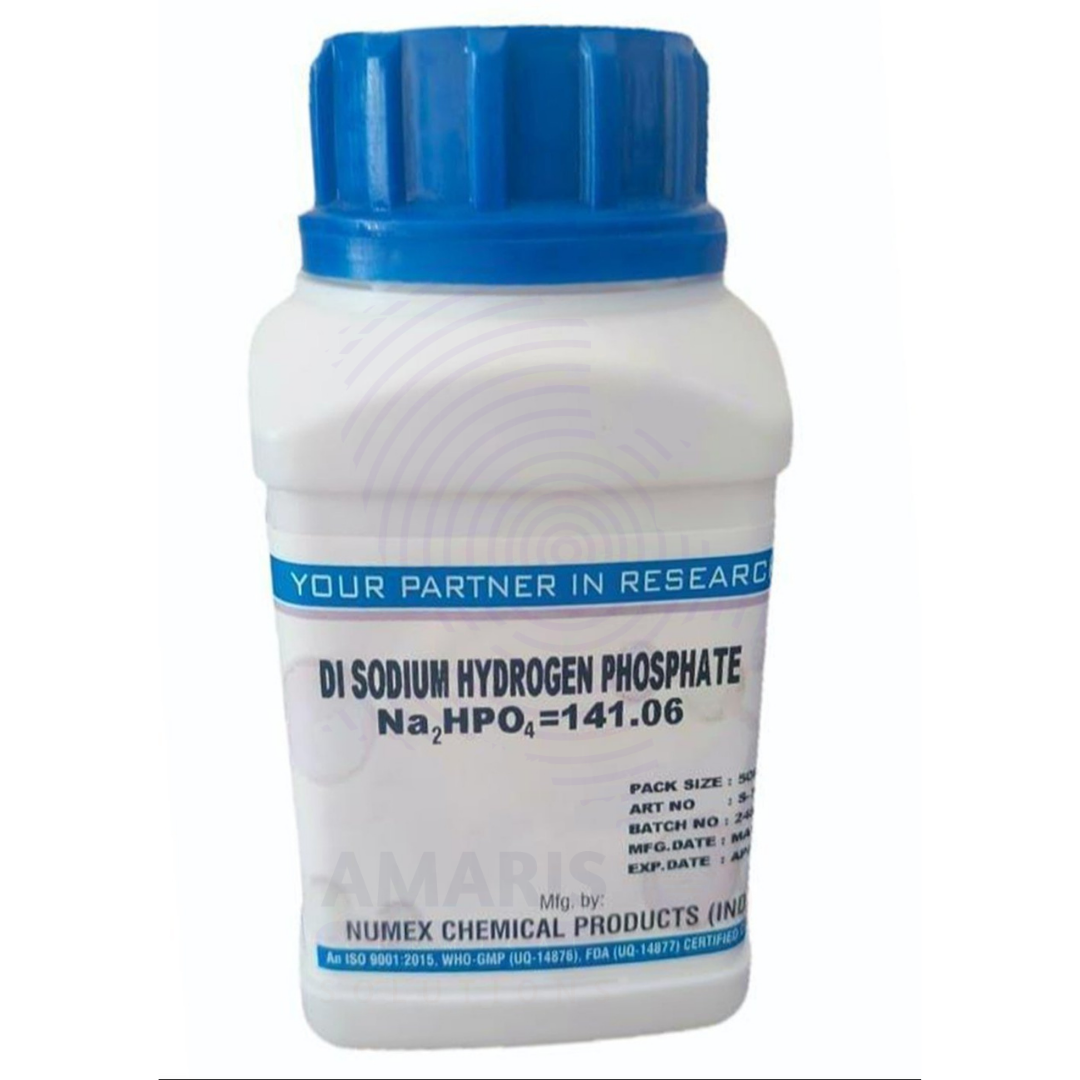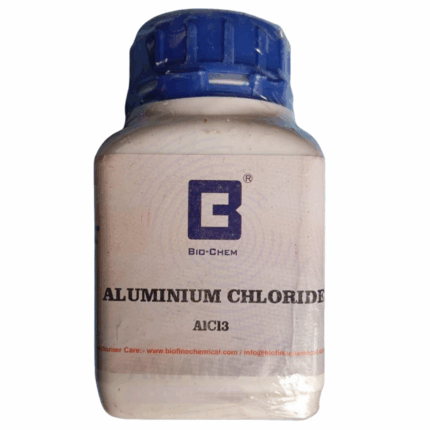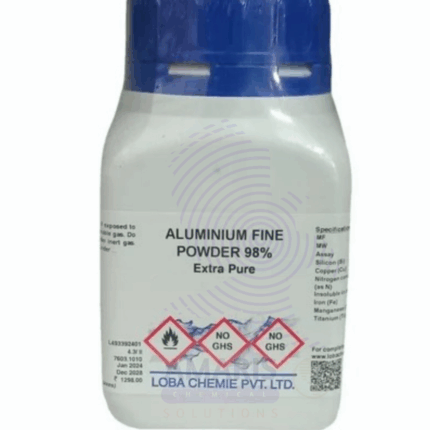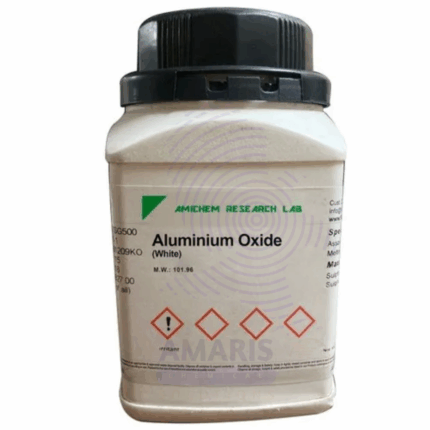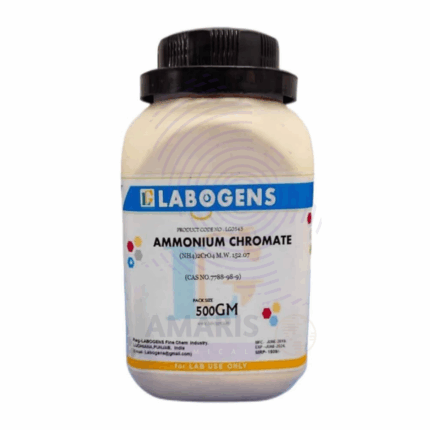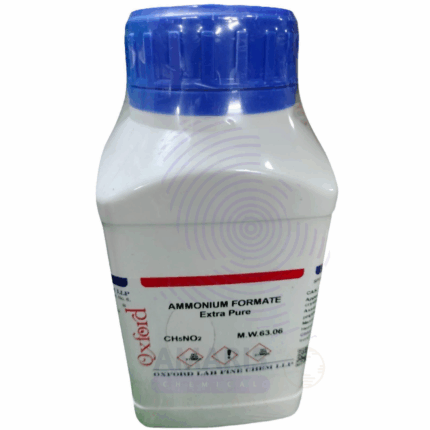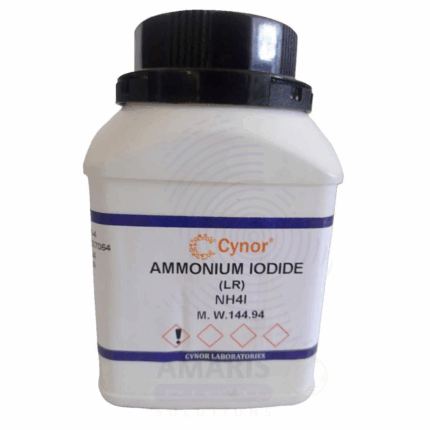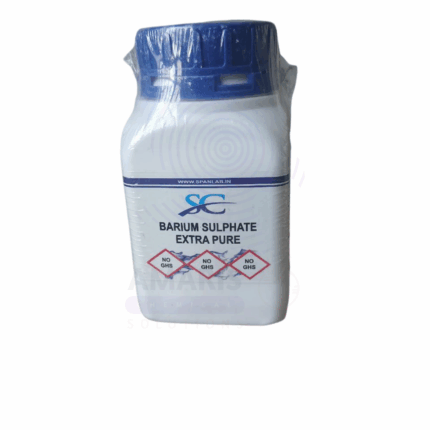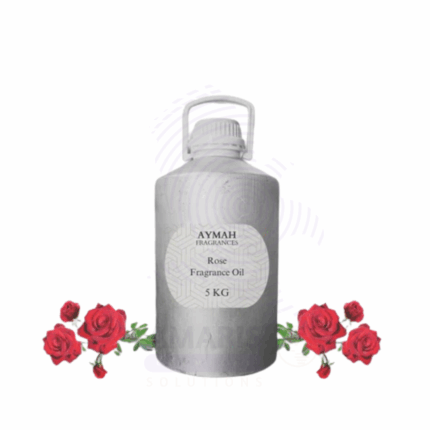
Rose Fragrance Oil
$ 20.00 Original price was: $ 20.00.$ 19.35Current price is: $ 19.35.
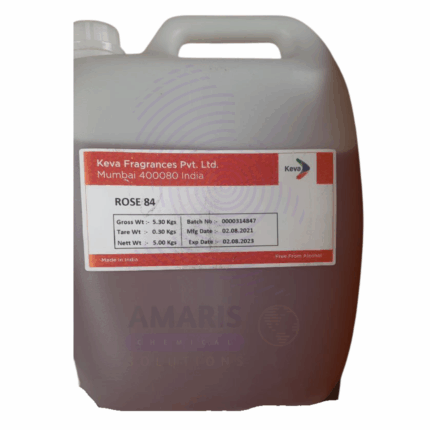
Rose Fragrance Water Soluble
$ 23.00 Original price was: $ 23.00.$ 22.44Current price is: $ 22.44.
Disodium Hydrogen Phosphate Extra Pure
$ 19.20
Whatsapp Order
Disodium Hydrogen Phosphate Extra Pure is a high-purity, anhydrous inorganic salt widely used in laboratory settings as a buffering agent, pH regulator, and reagent in chemical analysis. It plays a crucial role in preparing phosphate buffer systems for biochemical assays, molecular biology protocols, and microbial culture media. With its reliable solubility and consistent reactivity, it supports accurate calibration of pH in solutions. Its extra pure grade ensures minimal contamination, making it ideal for use in sensitive analytical and research environments. Proper storage in airtight containers is recommended to prevent moisture absorption and preserve its effectiveness.
Description
Table of Contents
Toggle
Disodium Hydrogen Phosphate Extra Pure
Primary Uses
- Buffer solution preparation (especially in phosphate buffer systems):
Essential in preparing phosphate buffers for biochemistry, molecular biology, and analytical chemistry applications. - Reagent in analytical chemistry:
Used in assays, titrations, and chemical analysis procedures. - Component of phosphate-buffered saline (PBS):
Combined with sodium dihydrogen phosphate to create isotonic solutions for maintaining biological specimen stability. - pH control and stabilization:
Employed in aqueous systems to maintain a constant pH environment. - Culture media preparation:
Used as a buffering agent in microbiological media to support microbial growth.
Secondary Uses
- Teaching and educational demonstrations:
Commonly included in lab experiments involving acid-base equilibria and buffer capacity. - Standardizing chemical solutions:
Sometimes used in standardizing acids and bases due to its buffering properties. - Research in water softening and treatment processes:
Investigated in simulated lab environments for its phosphate content and ability to prevent scale formation. - Ionic strength adjustment in biochemical reactions:
Helps create suitable conditions for enzyme activity or protein behavior studies.
Additional information
| PACK SIZE |
500 grams Plastic Tin |
|---|
KEY PRODUCT FEATURES
1. Basic Identification Attributes
- Chemical Name: Disodium Hydrogen Phosphate
- Other Names: Disodium phosphate, Sodium phosphate dibasic
- Chemical Formula: Na₂HPO₄
- CAS Number: 7558-79-4 (anhydrous)
- Grade: Extra Pure (Laboratory Grade)
- Molecular Weight: 141.96 g/mol (anhydrous)
- Appearance: White crystalline or granular powder
- Odor: Odorless
2. Physical & Chemical Properties
- Melting Point: ~250 °C (decomposes)
- Solubility in Water: Freely soluble
- pH (1% solution): ~8.8 – 9.2
- Density: ~1.7 g/cm³
- Hygroscopicity: Hygroscopic
- Stability: Stable under normal lab conditions
3. Safety & Hazard Attributes
- GHS Classification: Not classified as hazardous
- Hazard Statements: None
- PPE Requirements:
- Lab coat
- Nitrile gloves
- Eye protection (safety goggles)
- First Aid Measures:
- Inhalation: Move to fresh air
- Skin Contact: Wash with water
- Eye Contact: Rinse thoroughly with water
- Ingestion: Rinse mouth; seek medical advice if necessary
4. Storage & Handling Attributes
- Storage Conditions:
- Keep container tightly closed
- Store in a cool, dry place
- Protect from moisture
- Handling Notes:
- Avoid inhaling dust
- Practice good laboratory hygiene
- Avoid contact with strong acids
5. Regulatory & Compliance Attributes
- EC Number: 231-448-7
- REACH Status: Registered
- UN Number: Not regulated
- DOT/ADR Classification: Not regulated
- Hazard Class (Transport): Non-hazardous
6. Laboratory Applications
- Primary Uses:
- Component in phosphate buffer systems
- pH control in chemical and biological solutions
- Reagent in analytical chemistry
- Use in molecular biology and biochemistry
- Other Uses:
- Water treatment studies
- Food-grade research (not for direct consumption in this grade)
- Educational demonstrations and buffer preparation
SAFETY HANDLING PRECAUTIONS
SAFETY PRECAUTIONS
- PPE Required:
- Safety goggles
- Lab coat
- Protective gloves
- Storage Recommendations:
- Store in a tightly sealed container
- Keep in a dry, well-ventilated area
- Avoid contact with moisture and acids
- Handling Precautions:
- Avoid generating dust
- Wash hands thoroughly after handling
FIRST AID MEASURES
- Inhalation: Move to fresh air; seek attention if symptoms develop
- Skin Contact: Wash with soap and water
- Eye Contact: Rinse cautiously with water for several minutes
- Ingestion: Rinse mouth; do not induce vomiting unless directed by medical personnel
FIRE FIGHTING MEASURES
- Flammability: Non-flammable
- Incompatible Materials: Strong acids (may release heat and form phosphoric acid)
- Thermal Decomposition: May produce sodium oxides and phosphorus oxides
Related products
Aluminium Chloride Anhydrous Extra Pure
Aluminium Chloride Anhydrous Extra Pure is a high-purity, white to yellowish crystalline compound that is highly hygroscopic and fuming in moist air. It is extensively used in laboratory chemistry as a powerful Lewis acid catalyst, particularly in Friedel-Crafts alkylation and acylation reactions, as well as in the synthesis of organometallic compounds. Its anhydrous form ensures optimal reactivity and effectiveness in moisture-sensitive processes, including polymerization and halogenation studies. Due to its corrosive nature and tendency to react violently with water, it must be handled in a dry, controlled environment using proper safety measures. This extra pure grade is ideal for high-precision analytical and preparative procedures in organic and inorganic chemistry research.
Aluminium Metal Fine Extra Pure
Aluminium Metal Fine Extra Pure is a high-purity, silvery-grey powder composed of finely divided aluminum particles, ideal for precision laboratory work and specialized chemical reactions. Known for its high surface area and excellent reactivity, it is widely used in thermite reactions, metallurgical experiments, and the synthesis of aluminum-based compounds. Its fine particle size enhances its role as a reducing agent in organic and inorganic chemistry, as well as in combustion and pyrotechnic research. The extra pure grade ensures minimal trace impurities, supporting consistent and accurate results in sensitive analytical and preparative procedures. Due to its flammability and potential for dust explosions, it must be handled with caution in well-ventilated areas and stored in sealed, moisture-free containers.
Aluminium Oxide Extra Pure
Aluminium Oxide Extra Pure is a high-purity, white, odorless crystalline powder widely used in laboratory applications for its chemical stability, hardness, and high melting point. It serves as a reliable reagent in inorganic synthesis, a polishing and grinding medium in sample preparation, and a support material for catalysts in chemical reactions. This form of alumina is also used in adsorption studies, ceramic research, and as a desiccant in controlled drying processes. Its extra pure grade ensures minimal contamination, making it suitable for sensitive analytical work and high-precision experiments. For optimal performance, it should be stored in a dry, tightly sealed container to prevent moisture absorption and maintain its physical integrity.
Ammonium Chromate Extra Pure
Ammonium Chromate Extra Pure is a high-purity, yellow crystalline compound primarily used in laboratory settings for analytical and inorganic chemistry applications. It serves as a strong oxidizing agent and is commonly utilized in qualitative analysis, particularly in the detection of cations, and in the preparation of chromate-based reagents. Its high solubility in water and ability to act as a corrosion inhibitor also make it useful in material science and electrochemical experiments. Due to the presence of hexavalent chromium, it is toxic and environmentally hazardous, requiring strict handling procedures and protective equipment. The extra pure grade ensures minimal impurities, making it suitable for high-precision research. It must be stored in tightly sealed containers, away from light, heat, and incompatible substances.
Ammonium Formate Extra Pure
Ammonium Formate Extra Pure is a high-purity, white crystalline compound commonly used in laboratory chemistry as a buffering agent, reducing agent, and reagent in organic synthesis. It plays a significant role in catalytic hydrogenation reactions, particularly in transfer hydrogenation using palladium or platinum catalysts. In analytical chemistry, it is frequently used in HPLC and mass spectrometry applications due to its volatility and compatibility with aqueous and organic mobile phases. The extra pure grade ensures extremely low levels of impurities, making it suitable for high-precision and instrument-sensitive applications. It should be stored in a cool, dry, and tightly sealed container to preserve its stability and prevent moisture uptake.
Ammonium Iodide Extra Pure
Ammonium Iodide Extra Pure is a high-purity, white to slightly yellow crystalline compound highly soluble in water and alcohol, commonly used in laboratory chemistry for analytical, synthetic, and photographic applications. It serves as a valuable source of iodide ions in organic and inorganic reactions, including halide exchange and the preparation of iodine-containing compounds. In analytical chemistry, it is used in iodometric titrations and as a reagent for detecting metal ions. The extra pure grade ensures exceptional chemical stability and low levels of impurities, supporting accurate, reproducible results in sensitive experiments. It should be stored in tightly sealed containers, away from light and moisture, to prevent decomposition and discoloration.
Barium Sulphate Extra pure
Barium Sulphate Extra Pure is a high-purity, white, odorless crystalline powder known for its extreme insolubility in water and chemical inertness, making it highly useful in laboratory settings for qualitative analysis and gravimetric determinations. It is commonly employed in the detection and quantification of sulfate ions through precipitation reactions, as well as in studies involving solubility equilibria and surface chemistry. Its high density and stability also make it valuable in preparing calibration standards and radiopaque materials in research. The extra pure grade ensures minimal contamination, providing consistent and reliable results in sensitive analytical procedures. It should be stored in a dry, tightly sealed container to maintain its quality and prevent contamination.


 Preservatives(food)
Preservatives(food) Flavor Enhancers
Flavor Enhancers Acidulants
Acidulants Sweeteners
Sweeteners Antioxidants
Antioxidants Colorants(food)
Colorants(food) Nutraceutical Ingredients (food)
Nutraceutical Ingredients (food) Nutrient Supplements
Nutrient Supplements Emulsifiers
Emulsifiers
 Collectors
Collectors Dust Suppressants
Dust Suppressants Explosives and Blasting Agents
Explosives and Blasting Agents Flocculants and Coagulants
Flocculants and Coagulants Frothers
Frothers Leaching Agents
Leaching Agents pH Modifiers
pH Modifiers Precious Metal Extraction Agents
Precious Metal Extraction Agents
 Antioxidants(plastic)
Antioxidants(plastic) Colorants (Pigments, Dyes)
Colorants (Pigments, Dyes) Fillers and Reinforcements
Fillers and Reinforcements Flame Retardants
Flame Retardants Monomers
Monomers Plasticizers
Plasticizers Polymerization Initiators
Polymerization Initiators Stabilizers (UV, Heat)
Stabilizers (UV, Heat)
 Antifoaming Agents
Antifoaming Agents Chelating Agents
Chelating Agents Coagulants and Flocculants
Coagulants and Flocculants Corrosion Inhibitors
Corrosion Inhibitors Disinfectants and Biocides
Disinfectants and Biocides Oxidizing Agents
Oxidizing Agents pH Adjusters
pH Adjusters Scale Inhibitors( water)
Scale Inhibitors( water)
 Antioxidants(cosmetic)
Antioxidants(cosmetic) Emollients
Emollients Fragrances and Essential Oils
Fragrances and Essential Oils Humectants
Humectants Preservatives
Preservatives Surfactants(cosmetic)
Surfactants(cosmetic) Thickeners
Thickeners UV Filters
UV Filters
 Fertilizers
Fertilizers Soil Conditioners
Soil Conditioners Plant Growth Regulators
Plant Growth Regulators Animal Feed Additives
Animal Feed Additives Biostimulants
Biostimulants Pesticides (Herbicides, Insecticides, Fungicides)
Pesticides (Herbicides, Insecticides, Fungicides)
 Active Pharmaceutical Ingredients (APIs)
Active Pharmaceutical Ingredients (APIs) Excipients
Excipients Solvents(pharmaceutical)
Solvents(pharmaceutical) Antibiotics
Antibiotics Antiseptics and Disinfectants
Antiseptics and Disinfectants Vaccine Adjuvants
Vaccine Adjuvants Nutraceutical Ingredients (pharmaceutical)
Nutraceutical Ingredients (pharmaceutical) Analgesics & Antipyretics
Analgesics & Antipyretics
 Analytical Reagents
Analytical Reagents Solvents(lab)
Solvents(lab) Chromatography Chemicals
Chromatography Chemicals Spectroscopy Reagents
Spectroscopy Reagents microbiology-and-cell-culture-reagents
microbiology-and-cell-culture-reagents Molecular Biology Reagents
Molecular Biology Reagents Biochemical Reagents
Biochemical Reagents Inorganic and Organic Standards
Inorganic and Organic Standards Laboratory Safety Chemicals
Laboratory Safety Chemicals Specialty Laboratory Chemicals(Special Laboratory Equipment)
Specialty Laboratory Chemicals(Special Laboratory Equipment)
 Demulsifiers
Demulsifiers Hydraulic Fracturing Fluids
Hydraulic Fracturing Fluids Scale Inhibitors(oil)
Scale Inhibitors(oil) Surfactants(oil)
Surfactants(oil) Drilling Fluids
Drilling Fluids
 Dyes and Pigments
Dyes and Pigments Bleaching Agents
Bleaching Agents Softening Agents
Softening Agents Finishing Agents
Finishing Agents Antistatic Agents
Antistatic Agents
 Admixtures
Admixtures Waterproofing Agents
Waterproofing Agents Sealants and Adhesives
Sealants and Adhesives Curing Compounds
Curing Compounds Concrete Repair Chemicals
Concrete Repair Chemicals Anti-Corrosion Coatings
Anti-Corrosion Coatings
 Surfactants(cleaning)
Surfactants(cleaning) Builders
Builders Enzymes
Enzymes Solvents (Cleaning)
Solvents (Cleaning) Fragrances
Fragrances
 Electronic Chemicals
Electronic Chemicals Catalysts
Catalysts Lubricants
Lubricants Photographic Chemicals
Photographic Chemicals Refrigerants
Refrigerants Automotive chemicals
Automotive chemicals Pyrotechnic Chemicals
Pyrotechnic Chemicals
 Biodegradable Surfactants
Biodegradable Surfactants Bio-based Solvents
Bio-based Solvents Renewable Polymers
Renewable Polymers Carbon Capture Chemicals
Carbon Capture Chemicals Wastewater Treatment Chemicals
Wastewater Treatment Chemicals
 Pigments
Pigments Solvents(paint)
Solvents(paint) Specialty Coatings
Specialty Coatings Binders/Resins
Binders/Resins Additives
Additives Driers
Driers Anti-Corrosion Agents
Anti-Corrosion Agents Functional Coatings
Functional Coatings Application-Specific Coatings
Application-Specific Coatings
 Fresh Herbs
Fresh Herbs Ground Spices
Ground Spices Whole Spices
Whole Spices Spice Blends
Spice Blends Dried Herbs
Dried Herbs
 Leavening Agents
Leavening Agents Dough Conditioners
Dough Conditioners Flour Treatments
Flour Treatments Fat Replacers
Fat Replacers Decoratives
Decoratives Preservatives(baking)
Preservatives(baking)
 Plasticizers & Softeners
Plasticizers & Softeners Reinforcing Agents
Reinforcing Agents Adhesion Promoters
Adhesion Promoters Vulcanizing Agents
Vulcanizing Agents Antidegradants
Antidegradants Blowing Agents
Blowing Agents Fillers & Extenders
Fillers & Extenders Accelerators & Retarders
Accelerators & Retarders